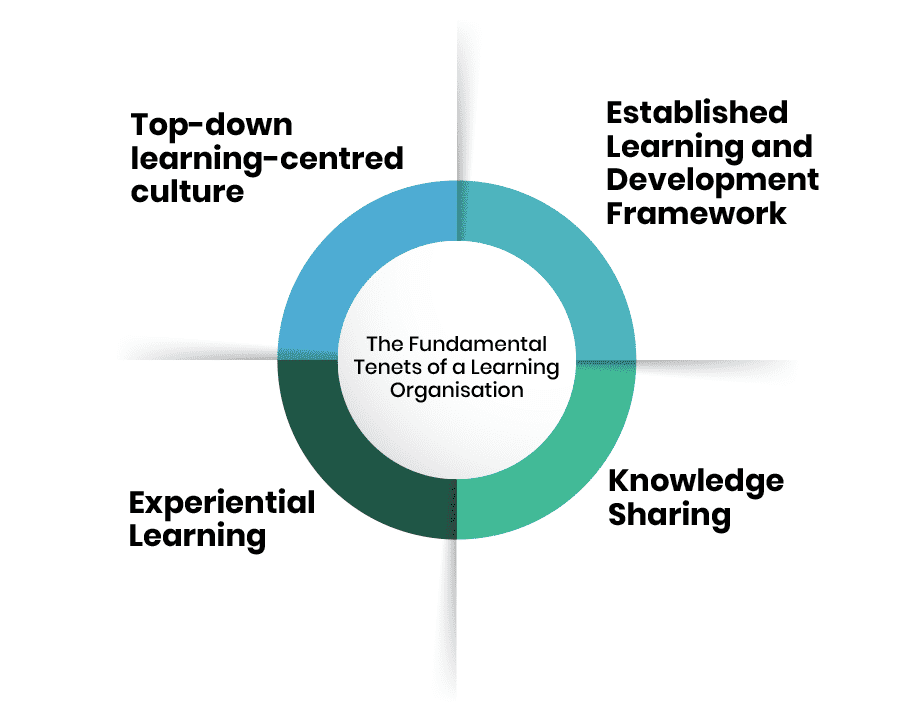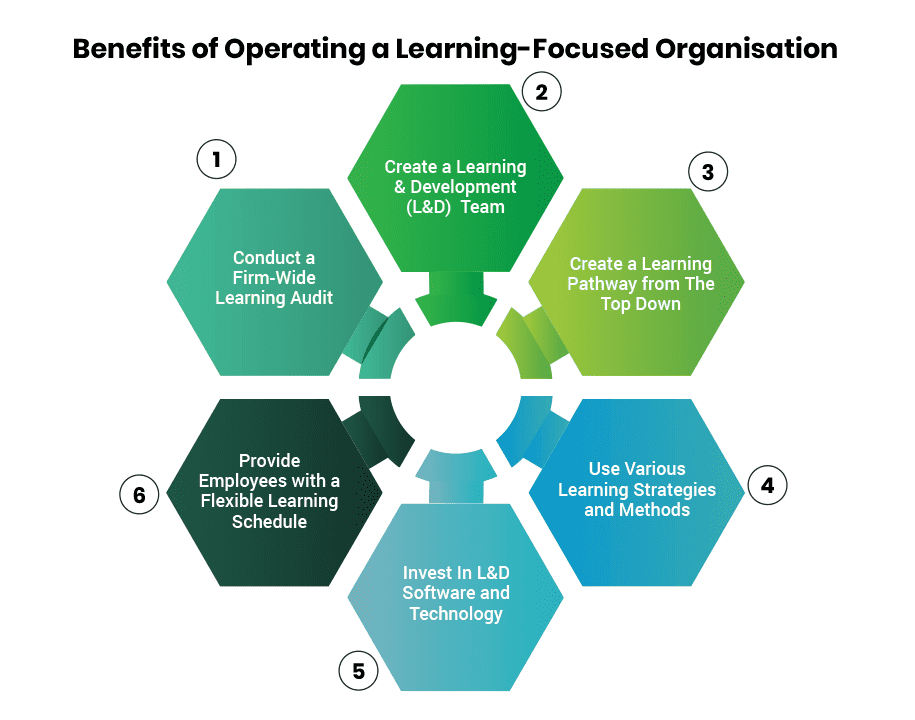In today’s dynamic business environment, organisations face increasing complexity in their business operations and retaining and sustaining a high-performing workforce. But what can they do to deal with these complexities?
In 1990, systems scientist and author Peter Senge published The Fifth Discipline: The Art & Practise of the Learning Organisation. According to him, these are places “where people continually improve their capacity to create the results they genuinely desire, where new and expansive patterns of thought are nurtured, where collective aspiration is set free, and where people constantly learn together.
Many prosperous organisations, including Google, adopted the learning organisation concept that Peter Senge popularised. However, due to the disruptions that every business globally has faced in recent times, particularly in the retention and sustainability of a fully optimised workforce, it is now essential for organisations to adopt a learning business framework to stay competitive, retain and sustain a high-performing workforce, better manage change, and thrive in an ever-more turbulent economy. Furthermore, developing and implementing this learning model necessitates more than just a training plan and budget; it requires businesses to have a comprehensive learning strategy and commitment from all cadres of staff to learning to provide a competitive advantage, leading to brand equity competitors cannot match, and attract and retain the best talents.
What Is a Learning-Focused Organisation?
A learning-focused organisation differs from a conventional one. It puts learning at the forefront of the corporate culture and prioritises the training and development of employees. It is an organisation that appreciates every opportunity to educate its workforce, identify their talents and skills, and upskill them so that the company and its workers can succeed in the face of change.
Employees in this organisation use their own and other people’s experiences to improve performance and view success and failure as learning and development opportunities. In addition, these organisations create an environment where people can learn more quickly and effectively.
The company’s business structure is built around continuous learning, which is promoted and modelled by all levels of staff, including the CEO and senior management. Every employee in this type of organisation understands that continuous learning is expected and should not be rewarded. However, becoming one and maintaining this framework can take time due to the amount of effort, dedication, energy, and resources required. Nonetheless, the advantages of running a learning-focused organisation outweigh all prerequisites if you want to keep your talent and pursue a high-performing workforce.
The Fundamental Tenets of a Learning Organisation
-
Top-down learning-centred culture
One of the principles of becoming a learning-focused organisation is to foster a learning culture tailored to each employee and ensure that everyone is committed to one form of personal development. The leadership team needs to set an example for the rest of the organisation by participating in learning and development initiatives, exhibiting learning behaviours, and sharing firsthand experiences with the staff. Your organisation’s learning departments can emphasise the value of learning at all levels by implementing an employee development programme that engages the workforce and offers in-depth details about the benefits of acquiring new knowledge and skills.
-
Established Learning and Development Framework
Learning-focused organisations’ processes, strategies, and frameworks are well-established and readily available to employees. If learning is to become a habit and a daily practice, employees must be fully aware of what is expected of them and feel comfortable participating. Making this a reality for business may be made possible by formally kicking off and introducing an L&D strategy when it is updated or launched.
-
Experiential Learning
The ability of employees to learn from their own and other people’s experiences is one of the cornerstones of a learning organisation. Sharing knowledge and expertise is a priority for learning organisations to keep things moving and stop the cycle of recurrent mistakes that can hinder businesses from succeeding.
-
Knowledge Sharing
In addition, knowledge exchange is essential in organisations that promote learning. These companies value communication highly as it encourages cooperation, creativity, and teamwork. Employees at learning organisations are encouraged to share their perspectives on their work.
Benefits of Operating a Learning-Focused Organisation
The following are some of the primary benefits of becoming a learning-focused organisation:
-
Retention of Top Talents
One of the primary benefits of implementing a learning-based organisational model is that it promotes long-term employee retention, particularly of your top talent, resulting in a high-performing workforce. Furthermore, we have seen that organisations that do not operate a learning framework lose out on retaining their top talent and have a workforce that is not fully optimised. Employees in such organisations will actively seek other opportunities.
-
Upsurge In Originality and Creativity
While innovation and creativity cannot be forced, they can be fostered in the right environment with the right blend of culture, leadership, talent, and approach, allowing employees to innovate. The learning organisation framework helps businesses by encouraging innovation through brainstorming, enabling workers to excel when given the time and space to learn new things, pursue interests, and share insights.
-
Increase In Employees’ Productivity and Efficiency
Employees who work for organisations that operate a learning business model feel well-equipped to excel in their roles and are productive, especially when they perceive that the organisation is highly engaging, motivating, and creating learning pathways for them to learn about their work, industry, and employer, which in the long run results in a reduction in costs, an increase in revenue, and a decrease in employee turnover.
-
Change-Adaptation Skills Among Employees
Due to employees’ easy access to information and ability to share pertinent information, learning organisations can quickly respond to external pressures and adapt to changes and trends. Employees can adjust to new circumstances quicker in these organisations than in those where knowledge is harder to access.
-
Increased collaboration and knowledge sharing
Large organisations may have departments and employees that are isolated from one another, leaving some groups or employees unaware of the organisation’s objectives. Therefore, a learning-focused organisation enables knowledge sharing, boosting efficiency and fostering connections and collaboration. It also promotes understanding and guarantees that everyone knows what is required to succeed, preventing employees from wasting valuable time and effort reinventing the wheel.
-
Better Stakeholder Management
It is easier for organisations to match resources with stakeholder needs when learning is prioritised. Because of the framework used in this type of organisation, there is a free flow of information to employees that will benefit stakeholders by enabling them to stay current on what they seek and develop new ways to offer better experiences.
Tips for Creating a Successful Learning-focused Organisation
- Conduct a Firm-Wide Learning Audit: A learning audit is an excellent place to start, as it allows you to identify learning and development gaps within the organisation and gauge your employees’ readiness and preparedness to learn. You should ask yourself as a company, “Where do we want to be, and how can we get there?”
- Create a Learning & Development (L&D) Team: Organisations should prioritise learning and development initiatives rather than making it just a one-off exercise. Create a team of employees from various business units to collaborate and develop L&D initiatives suitable for multiple departments and the organisation. These team members should meet frequently to assess progress and make changes for the future. They can use data from L&D software, personal experience, and survey data to guide their work.
- Create A Learning Pathway from The Top Down: Driving learning from the top down is one of the tips to becoming a successful learning-focused organisation. The L&D team should work with every employee to spread learning-centric messages throughout the organisation, and leaders should show that they are invested in the success of the L&D initiatives.
- Use Various Learning Strategies and Methods: Different employees learn best in multiple settings and with diverse learning styles and technology. Learning organisations should be open to these differences and let team members use the methods of learning that they find most appealing.
- Invest In L&D Software and Technology:Organisations prioritising learning should invest in L&D software suitable for their needs and scale because it promotes internal learning, reduces the cost of external spending, and allows programmes to be customised based on their needs and pain points. It also enables organisations to monitor their staff members’ learning and developmental progress and informs you of the training they will need to advance and develop.
- Provide Employees with A Flexible Learning Schedule:Modern workplace requirements necessitate flexibility in learning and working methods. Learning-focused organisations should incorporate flexibility and agility into L&D projects to allow team members to work on the lessons that best suit them on their schedules. Learning can be made simple and enjoyable by using L&D software that is mobile device compatible and accessible to all staff members.
Finally, becoming a learning-focused organisation enables you to have a high-performing workforce that can manage and navigate change. Furthermore, every learning organisation must also make lifelong learning a priority. Once it has started, it must be allowed to keep ingraining itself into the organisational culture without interruption.
Written by:
Oluwashola Achara
Learning Experience Designer


